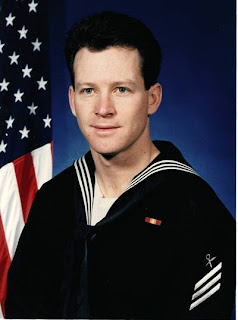Mail Call
 Mail call was infrequent that first month as we headed to Hong Kong.
Mail call was infrequent that first month as we headed to Hong Kong.We picked up a load in Hawaii, but after that it was infrequent as we headed further west over the Pacific. But when it came, people were excited. It arrived on a particular plane -- called the "COD" for carrier onboard delivery -- and many of the veteran sailors could recognize the sound and vibration of the COD's twin propellers when it landed.
Once the postal clerks sorted it all by department and division, the call would go out over the 1MC: "mail call, mail call." Those were happy words to hear.
Me and a couple of the other guys were usually sent to pick it up. The Nimitz itself was an industrial labyrinth. It took me a week or two just to feel confidant that I could make my way between our birthing, the office, and the mess decks without getting lost. So, on that first mail run, I just followed the other guys.
The mail itself was given to us in huge, unwieldy nylon bags, which made navigating the narrow passageways or "p-ways" back to the intelligence office more challenging. That's when I hit something. With the mail bag slung over my right shoulder and the bill of my Nimitz ball cap pulled down, I never saw the large metal bar protruding into the p-way. It didn't hurt too bad, but when I dropped the mail bag and put my hand under my hat, it came back covered in blood.
The ship's medical department was staffed by hospital corpsmen. There was one, maybe two, medical doctors on board, but the bulk of the work was done by the enlisted corpsmen. And when I got to medical, I was attended to by two of them: one, a more experienced petty officer, the other, a newbie -- a seaman, like me. It was clear that I needed three or four stitches just above my hairline.
"Hey, would you mind if I let him do the stitching?" The petty officer was referring to his young charge. "He needs to get qualed and I'll be here the whole time supervising."
Just like all the other enlisted rates, hospital corpsmen had to get certain qualifications before being permitted to take an advancement exam for promotion. New intelligence specialists like me, for example, might have to make a photo mosaic, among other things, before sitting for the exam. So, it made sense to me that the new corpsman would have to learn how to do stitches for real. Someone had to be his first patient.
"Sure," I said, "go ahead."
After about a half dozen shots of Novocaine in and around the wound, the young corpsman tentatively applied his first stitch, which made us both flinch -- first me, then him.
"Could you feel that?" he asked. He looked startled.
"Yeah, but just keep going."
"No, I better give you a couple more shots of Novocaine," he said.
"No, just finish the stitches." I was getting agitated. "It feels the same as the shots, so what's the difference." After he was finished, the petty officer told me to come back in three weeks or so to have the stitches removed.
Yeah, right.
Two and a half weeks later, I plucked one stitch out myself and had one of the other guys in my division remove the other three with his Leatherman. I taped them to a letter and sent them to Elaine.
The photo above is my official Nimitz photo, taken shortly before my trip to medical. The three slashes designated my rank (E-3 or Seaman, akin to a private in the Army). The crossed quill and magnifying glass designated my rate as an IS or Intelligence Specialist. I was already starting to look pretty pasty compared to my boot camp photo.



Comments